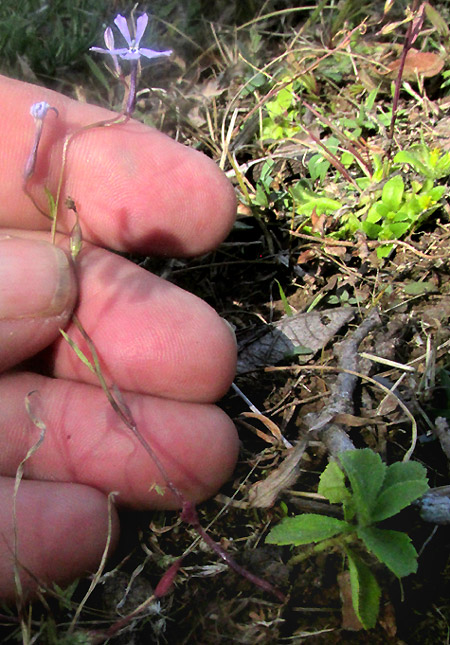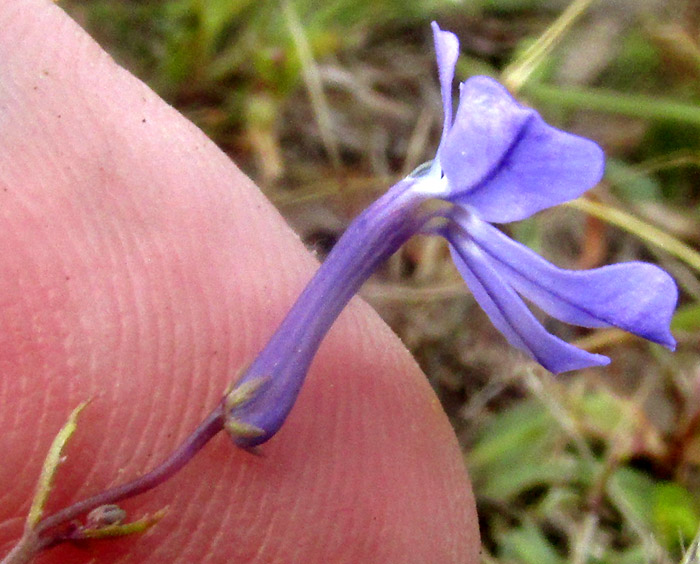Excerpts from Jim Conrad's
Naturalist Newsletter
Entry dated November 7, 2023, from notes taken at Cascadas de La Piedad waterfall 3kms NW of the community of San Pablo, municipality of Almeaco de Bonfil; atop beds of consolidated pumice and volcanic ash; N20.1003°, W100.0026°, elevation 2360 meters (7750ft); extreme southern Querétaro state, MÉXICO
LOBELIA DIVARICATA

On a steep bank of a narrow, moist, usually shaded, erosional gully about 300m northeast of the Cascada de La Piedad, or Piety Waterfall, the above wildflower stood in a narrow beam of sunlight entering the oak forest's canopy. It was unclear whether the green tuft of leaves were connected to the slender, flower-bearing stem, though now I think they were. What at first looked like a raceme-type inflorescence with bracteoles subtending each blossom, up close were seen as single flowers, each arising from the axil of the leaf below it. That detail was critical for identification to species level.

Up close, its blossoms were bilaterally symmetrical, with two-lobed upper corolla lips and three-lobed lower ones. With that, the corolla's blue color, and the flower's five fused stamens with hairy anthers creating something ambiguous at the corolla mouth, the plant was easily recognizable as a lobelia, genus Lobelia, of the Bellflower Family, the Campanulaceae.

The corollas' lips arose from a slender tube, which bulged somewhat at the base, on the lower side. The flowers' stems, or pedicels, were dark magenta colored, as was the stem.

The emerging flowering stem and the tuft of green leaves at its side were covered with the same kind of hairiness, though their shapes were very different.
Currently Kew's Plants of the World Online database recognizes 441 accepted Lobelia species occurring worldwide. The 1997 Flora del Bajío, which includes plants of Querétaro state, recognizes about 15 species occurring here. Descriptions in the Flora lead us to Lobelia berlandieri var. seleriana, though Kew lists that varietal name as a synonym of LOBELIA DIVARICATA; the variety has been recognized as a distinct species, as it was thought to be when first named in 1838.
Despite the taxon having been known for a long time, and it being fairly widely distributed, from the uplands of northeastern Mexico south through the central mountains and spottily south into Chiapas, the species isn't well known. Good images of it other than of dried herbarium specimens are hard to find. Several similar-looking species exist -- such as Lobelia sartorii, also occurring in the area -- but in the end the plant's blue flowers each arising in the axil of a reduced leaf, the corolla's well developed tube with no side openings, the leaf shape, the stem's dark magenta color, and the moist habitat, all convincingly pointed to Lobelia divaricata.
Lobelia divaricata has no English name though in Spanish it's been called moradilla, something like "little purple thing," and té del llano, or "flatland tea." Several sources mention the species as medicinal, though I find no mention of how it's used. Many Lobelia species are considered poisonous. Back in Kentucky, Lobelia inflata commonly was encountered. It was known as Indian Tobacco, and various Native American groups used it medicinally, as well as an insecticide, and to smoke. Testing it, I ate a bit and got woozy enough to not eat it again, or any other Lobelia.